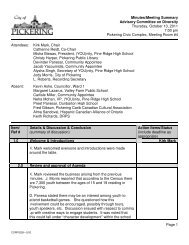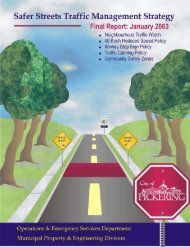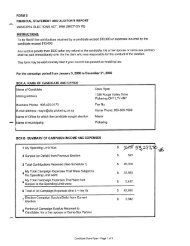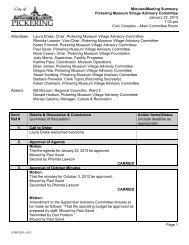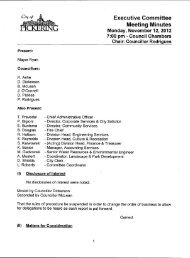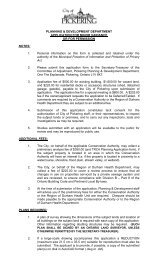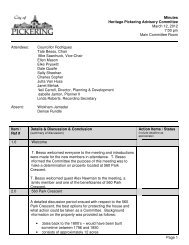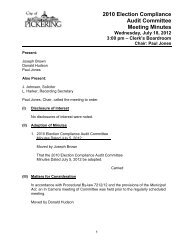Chapter A - Introduction - City of Pickering
Chapter A - Introduction - City of Pickering
Chapter A - Introduction - City of Pickering
You also want an ePaper? Increase the reach of your titles
YUMPU automatically turns print PDFs into web optimized ePapers that Google loves.
Comments in white are satisfied.<br />
Comments in orange background are not satisfied or are new comments.<br />
Comments in blue background can be addressed at the NFSSR stage.<br />
Comments in yellow are deferred due to need for hydrology model.<br />
APPENDIX A. TRCA COMMENTS ON SEATON MESPA DECEMBER 2011; MESPA TEAM RESPONSE FEBRUARY 2013<br />
# Section #<br />
Page # in<br />
PDF TRCA Comment Action Required<br />
72. 7.7.2 196 We are concerned that there will be impacts Provide water balance modeling to demonstrate no<br />
associated with wetlands where drainage is from impacts.<br />
an OSCA, given the intended land use.<br />
73. 7.7.2 197 The methodology used in the Time to Peak<br />
parameters for the feature based water balance<br />
should be consistent with the methodology used<br />
in the hydrology assessment.<br />
74. 7.7.3 198 The parameters for Figure B7.9 are not provided.<br />
This assessment is acceptable for the high level<br />
MESP, but we will need more detailed information<br />
at the NFSSR stage.<br />
75. 8.0 200 Further to OP policies, an LID strategy should be<br />
developed. The LID strategy should include<br />
assessing the water quality, water quantity, water<br />
balance and erosion control benefits <strong>of</strong> LID. This<br />
may reduce the number <strong>of</strong> wet ponds proposed<br />
and increase the amount <strong>of</strong> source and<br />
conveyance practices proposed.<br />
76. 8.0 200 Some areas in Seaton do not require quantity<br />
controls. The use <strong>of</strong> LID may eliminate the need<br />
for end <strong>of</strong> pipe solutions.<br />
77. 8.0 200 The Terms <strong>of</strong> Reference require the plan to<br />
ensure no <strong>of</strong>f site impacts related to flooding and<br />
erosion. Based on the results provided in the<br />
MESP, it appears this criteria has not been<br />
satisfied. In addition based on the above noted<br />
comments, <strong>of</strong>f site impacts may more significant<br />
than indicated in the report.<br />
78. 8.3 206 The text notes that rural road cross-sections are<br />
noted on Drawing B8.1; however, we were unable<br />
to find them.<br />
79. Figure B3.4 211 Cross-section ‘AA’ (east-west) faces north.<br />
However, ‘A’ is on the west side <strong>of</strong> the figure while<br />
‘A’ is actually the east side. The Figure should be<br />
labeled as (West-East). A plan has not been<br />
provided that illustrates the location <strong>of</strong> the crosssection<br />
within the study area.<br />
80. Figure B3.5 212 Cross-section ‘BB’ (north-south) faces east. A<br />
plan has not been provided that illustrates the<br />
location <strong>of</strong> the cross-section within the study area.<br />
Ensure consistent methodology.<br />
Consulting Team’s Response<br />
April 27, 2011<br />
The screening <strong>of</strong> wetlands for water balance<br />
assessment was based on changes in land use<br />
and contributing drainage areas, not the specific<br />
approach to stormwater. Wetland water<br />
balances were completed for OSCAs where<br />
appropriate.<br />
Is there a specific location <strong>of</strong> concern?<br />
The methodology to calculate the time to peak<br />
parameters will be updated as required. It<br />
should be noted that the value <strong>of</strong> the time to<br />
peak will not be the same as the drainage areas<br />
will not be the same.<br />
Action Taken<br />
MESPA December 2011<br />
Where required and applicable, further assessment<br />
occurred and text added to the OSCA pages<br />
(Appendix B8-C).<br />
With regard to the wetland east <strong>of</strong> Sideline 24, and<br />
south <strong>of</strong> Hwy 407 (Wetland G13), this wetland has<br />
been explicitly reviewed (see OSCA page,<br />
Appendix B8-C, Figure 22). It is primarily a cattail<br />
mineral shallow marsh that may expand to the east<br />
within the NHS.<br />
The MESPA includes the revised methodology<br />
(Sections B5.2, B5.4 and B7.4.2).<br />
Provide the parameters at the NFSSR stage. Acknowledged. In Section B7.4.2, the MESPA notes that the<br />
direction provided by Figure B7.5 (formerly Figure<br />
B7.9) is to be confirmed at the NFSSR stage<br />
through confirmation <strong>of</strong> modeling assumptions used<br />
to generate the relationships shown in the figure.<br />
Reassess the plan, and include a comprehensive<br />
assessment <strong>of</strong> LID measures.<br />
Reassess the plan, and include a comprehensive<br />
assessment <strong>of</strong> LID measures.<br />
The MESP LID strategy will be reviewed.<br />
Quantity control requirements are being updated<br />
through the hydrology update. The need for<br />
end-<strong>of</strong>-pipe solutions will be confirmed.<br />
A SWM/LID strategy is provided. (Sections<br />
B5.11.2 and B11.3)<br />
Detailed modelling and analysis, presented in<br />
Sections B5.0 through B9.0 identified storage and<br />
discharge design criteria, flood control<br />
requirements and erosion control resulting in the<br />
reduction <strong>of</strong> SWMFs to 60. The modelling has<br />
confirmed that these end-<strong>of</strong>-pipe solutions are<br />
required in addition to LID measures.<br />
Ensure this goal is articulated in the MESP. Under review. Section B5 has addressed potential <strong>of</strong>f-site<br />
impacts with respect to flooding for the 2 through<br />
100 year storm events and erosion. As presented<br />
in Section B5 discussions with agencies regarding<br />
the Regional storm event have been on-going<br />
regarding modelling approach and alternative<br />
potential management scenarios, and updated<br />
existing conditions model results. These<br />
discussions are ongoing and will continue over the<br />
next few months.<br />
Please provide the correct location for this<br />
information.<br />
Revise the graphic and provide a plan illustrating<br />
the location <strong>of</strong> the appropriate cross section.<br />
Provide a plan illustrating the location <strong>of</strong> the<br />
appropriate cross-section.<br />
Acknowledged.<br />
Acknowledged.<br />
Acknowledged.<br />
LID modelling assumed rural road cross sections in<br />
all locations where roads crossed the NHS. The<br />
exact sections <strong>of</strong> road that will have rural crosssections,<br />
the design and transition to urban cross<br />
sections will be determined at the NFSSR stage.<br />
The reference to the drawing is removed.<br />
The cross-section location key is added to Figure<br />
B3.3 and Figure B3.4 is revised appropriately.<br />
The cross-section location key is added to Figure<br />
B3.3; the cross-section is shown on Figure B3.5<br />
TRCA Comment on MESPA<br />
Comment addressed.<br />
Noted. To be reviewed with latest hydrology<br />
assessment.<br />
Noted.<br />
Addressed.<br />
To be reassessed when new hydrologic<br />
assessment is available.<br />
To be reassessed when new hydrologic<br />
assessment is available.<br />
Noted.<br />
Comment addressed<br />
Comment addressed<br />
Team Response<br />
February 2013<br />
No further changes made.<br />
The Erosion Analysis presented in the<br />
2011 MESPA in Section B5.9 and in the<br />
revised MESPA in Section B5.2 shows<br />
that LID measures in addition to end-f-pipe<br />
solutions are required.<br />
No response required – 2012 Duffins<br />
Creek Hydrology Update supersedes 2011<br />
MESPA.<br />
PAGE 16 February 2013



